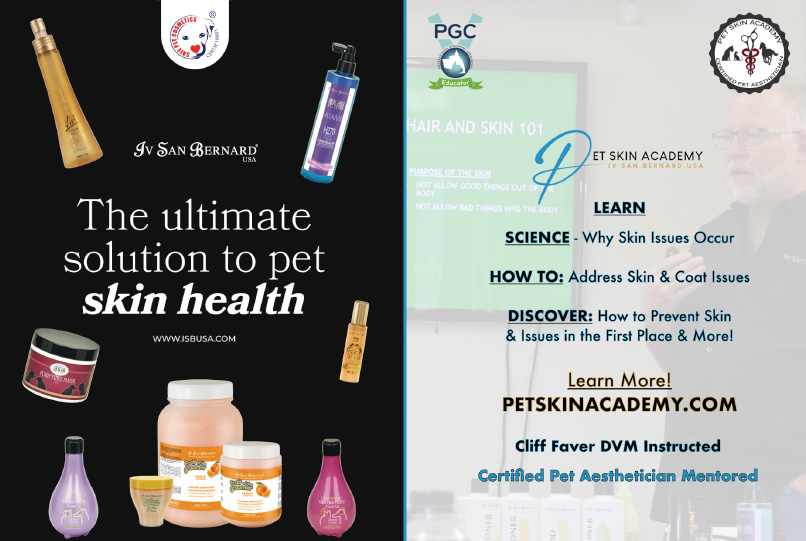





by Jennifer Bishop Jenkins
 og groomers don’t see breeds like Boxers, Doberman Pinschers, Bull Dogs or other mixed-breed smooth coats as often as we see doodles and other dogs with more hair. Some owners of these smooth-coated breeds mistakenly feel that their dogs don’t need grooming or even bathing. They may think of them as a “no care required” coat type instead of as the relatively easy but still “some care required” coat type they actually are. They require the same monthly bathing/toenails/skin care regimen that is recommended for all dogs; however, there are some key differences in the products and tools we must use for these smooth-coated breeds.
og groomers don’t see breeds like Boxers, Doberman Pinschers, Bull Dogs or other mixed-breed smooth coats as often as we see doodles and other dogs with more hair. Some owners of these smooth-coated breeds mistakenly feel that their dogs don’t need grooming or even bathing. They may think of them as a “no care required” coat type instead of as the relatively easy but still “some care required” coat type they actually are. They require the same monthly bathing/toenails/skin care regimen that is recommended for all dogs; however, there are some key differences in the products and tools we must use for these smooth-coated breeds.
Smooth Coat vs Short Coat
Both short coats and smooth coats do not need any trimming or cutting of hair when being groomed. They are bath/brush/nails-only dogs. Short coats do shed significantly more and generally need more work from the groomers in the removal of the shedding undercoat hairs. Smooth coats, lacking these undercoat hairs, need more skin care.
Their skin is much more exposed and at risk without that protective undercoat that short-coated breeds have, leaving them more susceptible to skin cancer and negative effects from the sun and other weather, and also much more vulnerable to parasites, skin infections and problems like yeast. And I rarely see a smooth coat like a Doberman or Boxer in my clientele that does not have dandruff that screams out how dry their coat and skin are.
The skin of these short- and smooth-coated breeds can also get particularly smelly compared to longer-haired dogs, which is why their skin needs more oils.
Veterinary dermatologists have defined three categories of hair in dogs: short, normal/natural and long. All three dermatological categories of dogs need all the things mammals need in skin: they all need oils; they all need minerals such as calcium, phosphorous, and magnesium—the building blocks of hair; and they all need moisturizers, collagen, humectants and emollients.1
Some companies cater to these different dermatological needs defined by veterinary dermatologists and manufacture shampoos that contain more oils for shorter smooth coats, more minerals for the medium normal/natural coats (like most double-coated dogs) and more moisturizers for long-coated dogs (dogs that need haircuts). Shampoo always removes oils and the protective barrier, so applying conditioner on every coat type every time is essential.
Instead, there are wonderful de-shedding “brushes” made of rubber or acrylic that will do a great job removing dead, shedding hairs from a smooth-coated dog. The soft nubs on these brushes will grab and remove any of the hairs that are ready to come out and leave behind the hairs not ready to fall out. They do no damage to their thin, fragile skin; in fact, their massaging action helps stimulate the skin.
It is best not to blow-dry these smooth-coated dog breeds—high-velocity dryers can be painful and even damaging. Their smooth coats have a tight grain, lay or direction to the hairs, and any HV dryer could hurt and tear delicate arrector pili muscles in their thin skin. But most importantly, the moisture from the bath/condition should be left on the coat while applying the oils. If they need more drying before going home, try a gentle fan in a warm room, or a very gentle warm-air crate dryer.
In addition, you can reach out to your area breeders through local kennel clubs and dog shows. Tell breeders that you have learned the differences in how to care for each coat type, and they will likely send their friends and puppy buyers to you because they know that you have the expertise to care for the different coat and skin types.
References:
- Muller and Kirk’s Small Animal Dermatology, 7e by Miller Jr. VMD DACVD, William H., Griffin DVM, Craig E., Ca 7th (seventh) Edition (2012)

